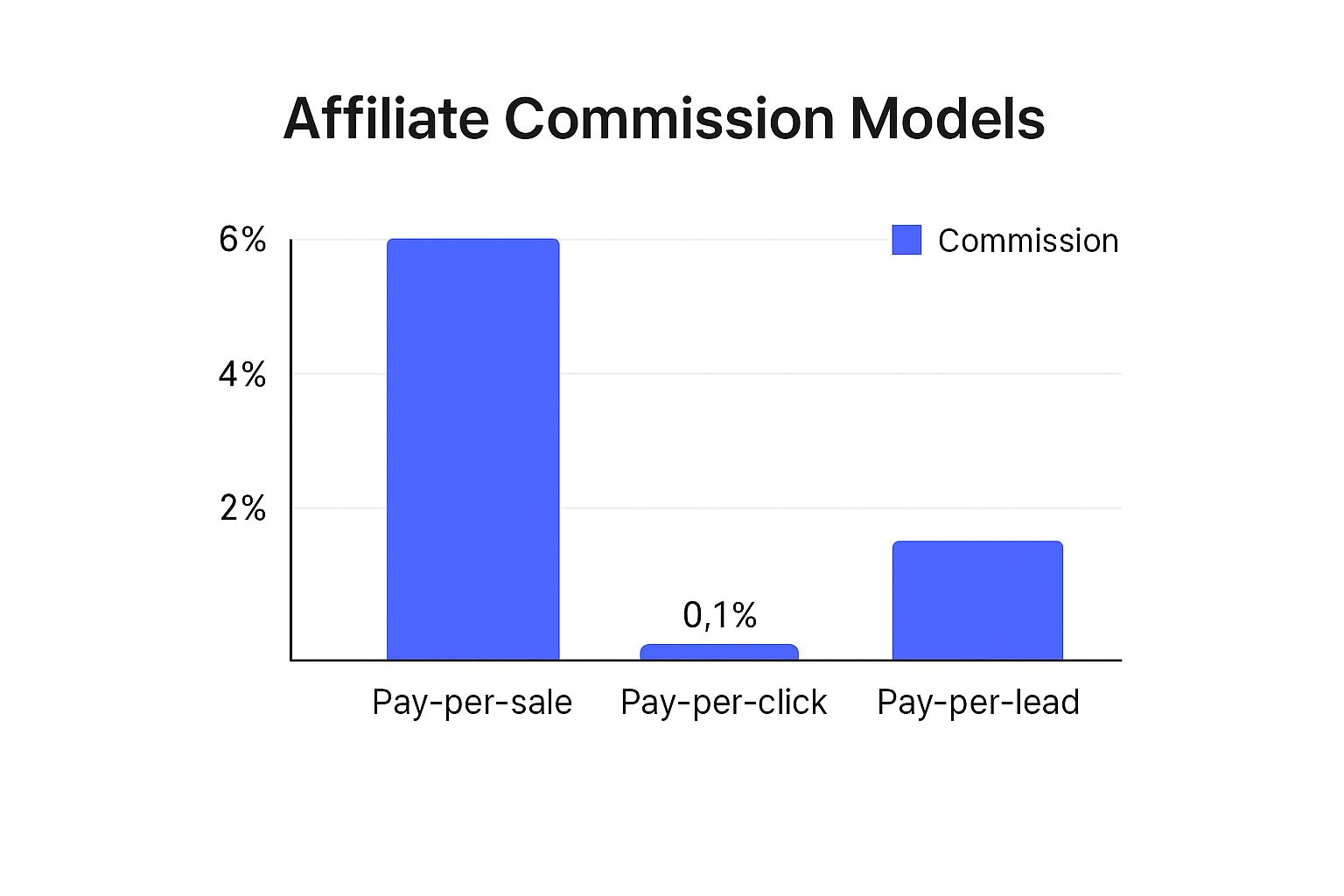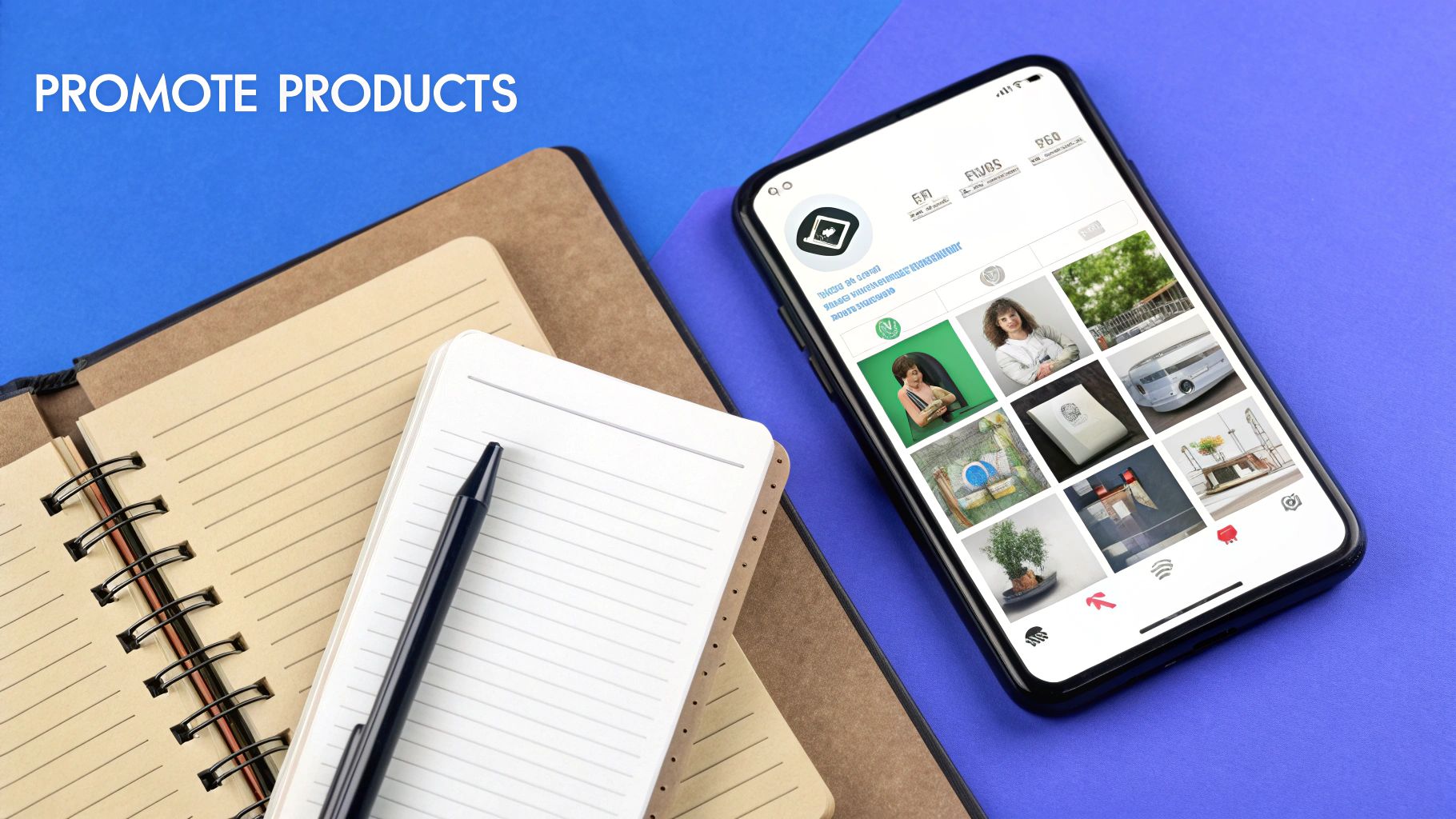Affiliate Marketing for Beginners Guide
Affiliate Marketing for Beginners Guide
Ollie Efez
September 10, 2025•21 min read

Ever heard of affiliate marketing but not quite sure what it is? Let's break it down.
At its core, affiliate marketing is a simple idea: you get paid a commission for promoting another company's products or services. You're essentially a freelance salesperson, and your payment is tied directly to the results you generate. Every time you send a paying customer to a business through your unique affiliate link, you earn a cut.
It's one of the most popular ways to make money online because you don't have to deal with creating, storing, or shipping your own products. You just focus on the marketing.
What Is Affiliate Marketing, Really?

Let's use a real-world example. Imagine you find a fantastic local coffee shop with the best espresso you've ever had. You can't stop raving about it to your friends. A few of them visit based on your recommendation and become regulars.
The coffee shop owner is thrilled with the new business and, as a thank you, offers you a free coffee every time you send a new customer their way.
That's affiliate marketing in a nutshell, just moved online. You're the friend with the great recommendation, the business is the coffee shop, and your commission is the free coffee. It's a true win-win-win situation for everyone.
The Key Players in the Process
To really get it, you need to know who's involved. There are three main parties that make the affiliate marketing engine run, and each one has a crucial role to play.
- The Merchant (or Brand): This is the creator of the product or service. It could be a giant like Amazon or a niche software company like LinkJolt. They want to sell more stuff, and they partner with affiliates to reach new audiences they couldn't otherwise.
- The Affiliate (That's You!): This is the person or company that promotes the merchant's product. As an affiliate, you might be a blogger, a YouTuber, or a social media influencer. Your job is to create helpful content that shows people how the product can solve their problems.
- The Consumer: This is the person who reads your blog post or watches your video, clicks your affiliate link, and buys the product. They're looking for honest advice to make a good purchasing decision, and they rely on your recommendation.
How Your Unique Link Works
The magic that holds this all together is your special affiliate link. Once you're accepted into an affiliate program, the merchant gives you a unique URL with a tracking ID that belongs only to you.
When someone clicks that link, a tiny file called a "cookie" is stored on their browser. This cookie acts like a digital note, telling the merchant, "Hey, this customer came from [Your Name]."
If that person makes a purchase within a certain window of time (called the "cookie duration"), the system knows you sent them. The sale is credited to your account, and you earn your commission. Simple as that.
Think of your affiliate link as your personal referral code. It’s what connects your marketing efforts to the final sale, making sure you get credit even if the customer buys the product days or weeks after clicking your link.
This tracking system is precisely why it’s called performance-based marketing. You’re paid for actual results—a sale, a lead, or a click. It’s not about some mysterious algorithm; it's about building trust with an audience and guiding them to a great product.
The Massive Opportunity in Affiliate Marketing
Let's get one thing straight: affiliate marketing isn't just some small-time side hustle. It's a gigantic, resilient industry that businesses—from tiny startups to global brands—rely on every single day. If you're just starting, it’s important to grasp this. You’re not just picking up a new hobby; you're stepping into a core part of the digital economy, and the potential for growth is enormous.
The numbers don't lie. This isn't a flash in the pan. It's a fundamental marketing strategy that companies are pouring serious money into, creating a stable and profitable world for affiliates to thrive in.
The Scale of the Affiliate Economy
The growth we're seeing isn't just steady—it's explosive. More and more businesses are shifting their marketing budgets to affiliate programs for one simple reason: they work. This continuous flow of investment opens up a constantly expanding pool of opportunities for creators who can connect brands with the right people.
Just look at the spending in the United States alone. In a single recent year, it hit roughly $9.56 billion, which was a huge 13.7% jump from the year before. And it’s not slowing down. Projections show that figure climbing to nearly $12 billion the following year and eventually soaring past $15.8 billion. That’s a massive 65% growth in just five years. For a deeper dive into these numbers, you can explore the full affiliate marketing statistics on Wix.com.
This consistent, double-digit growth is proof that businesses are all-in on affiliate partnerships. For you, the beginner, this means you're entering a market where your skills are in demand, not one that's already crowded and shrinking.
Why the boom? It all comes down to the model. Companies only pay when they get a real result, like a sale or a sign-up. It's a low-risk, high-reward channel for them, which makes you a direct partner in their success.
Why Now Is the Perfect Time to Start
This incredible growth translates directly into opportunity for you. As more businesses pile into the affiliate economy, the need for authentic promoters who can connect with a specific audience is only going to get bigger.
So, what does this mean for someone just getting started?
- More Choices: A bigger market means a ton more products and services to promote. This makes it so much easier to find programs that genuinely fit your niche and something you're actually passionate about.
- Greater Earning Potential: With billions on the table, companies are getting more competitive with their commission rates and bonus structures. This creates more chances for savvy affiliates to earn serious money.
- Future-Proof Skills: Learning how to build an audience and drive sales is a skill set that isn't going out of style. It will be valuable for years to come, no matter where your journey takes you.
Starting affiliate marketing today isn't about jumping on the bandwagon at the last minute. It's about getting in on an economic engine that's still picking up speed. The data points to a clear, promising path forward for anyone willing to learn the ropes and bring real value to an audience.
How to Start Your Affiliate Journey Step by Step

Jumping into affiliate marketing can feel like a huge undertaking, but it’s really just a series of small, concrete steps. Don't think of it as some impossible climb. It’s more like putting together a puzzle—you just have to find the right pieces and put them in the right order.
This roadmap will walk you through the entire process, from figuring out what you want to talk about to creating content that actually helps people. Follow along, and you'll build a brand people trust from the ground up. Let's get started.
Step 1 Find Your Niche
First things first, you need to decide on your niche. This is just a fancy word for the specific topic or industry you’re going to focus on. It’s the bedrock of your entire business, so choosing wisely is a big deal for your long-term success. The sweet spot is usually where your passion, your knowledge, and what people are actually looking for all meet.
What do you genuinely love talking about? Sustainable fashion? Home coffee brewing? Productivity software? That genuine enthusiasm is contagious, and it'll make creating content feel like fun, not a chore.
Next, think about what problems you can solve for people. Your own experiences are your biggest asset here. If you've figured out the secret to amazing gluten-free bread, you can be a huge help to others who are struggling with the exact same thing.
A niche that already has some competition is actually a good sign. It means there’s an audience ready to buy and companies willing to pay for referrals. Your job isn’t to be the only one, but to become a unique and trusted voice in the conversation.
Step 2 Choose Your Platform
Your platform is your home base—it's where you'll share your stuff and connect with your audience. Think of it as your digital storefront. While you can always expand later, it’s best to get really good at one platform before trying to juggle several.
Here are the most common starting points:
- A Blog: This is perfect for writing detailed product reviews, how-to guides, and side-by-side comparisons. Blogs are fantastic for drawing in traffic from search engines like Google and letting you build deep trust with your readers over time.
- A YouTube Channel: If you're more of a visual person, YouTube is amazing for product demos, unboxing videos, and tutorials. Video helps create a strong personal connection and is incredibly engaging.
- Social Media (Instagram, TikTok, Pinterest): These platforms are gold for visual niches like fashion, beauty, home decor, and food. You can show products in a real-world setting and build a tight-knit community with your posts.
Go with the platform where you feel most at home. If you love to write, start a blog. If you’re a natural on camera, fire up YouTube. Authenticity is everything, and it's so much easier to be authentic when you actually enjoy the medium you're using.
Step 3 Find and Join Affiliate Programs
Once you know where you’re setting up shop, it's time to find some products to promote. The goal is simple: partner with solid companies whose products your audience will genuinely find useful.
You can find programs in a few different ways:
- Go Direct to Company Websites: Many of the brands you already know and love have an "Affiliates" or "Partners" link tucked away in their website footer. This is a great place to start because you can recommend products you already trust from personal experience.
- Check Out Affiliate Networks: Think of these as giant marketplaces connecting you with thousands of companies. Big names like ShareASale, CJ Affiliate, and Impact Radius give you access to a massive variety of programs all in one place.
- Use Dedicated Platforms: Some tools, like the LinkJolt affiliate portal, act as a central hub where you can manage all your partnerships, making it way easier to track your earnings and performance across different brands.
When you're looking at programs, pay attention to their commission rates, cookie duration (how long you get credit for a sale after someone clicks your link), and, most importantly, the quality of their products. Never chase a high commission if it means promoting junk—it's the fastest way to lose the trust you've worked so hard to build.
Step 4 Create Valuable Content
This is where the magic happens. Your content is what pulls people in and convinces them to listen to what you have to say. The golden rule is to provide value first and promote second. Always.
Your content should be designed to solve a problem, answer a question, or simply entertain. So, instead of a blog post titled "Buy This Awesome Camera," you'd create something like "The Best Cameras for Beginner YouTubers in 2024." Inside that guide, you can review a few different cameras, break down the pros and cons, and then naturally place your affiliate links where they make sense.
The trick is to weave your recommendations into content that’s genuinely helpful. Your audience should walk away feeling like they learned something useful, even if they don’t click a single link. That’s how you build authority and make your recommendations feel like helpful advice from a friend instead of a sales pitch.
Step 5 Build and Nurture Your Audience
Getting those first few followers or readers is often the hardest part, but consistency is what will get you there. You have to show up regularly with great content to build momentum. It's a marathon, not a sprint.
To grow your audience, focus on what works for your specific platform. If you have a blog, you’ll want to learn the basics of Search Engine Optimization (SEO) so people can find you on Google. For a YouTube channel, that means creating eye-catching thumbnails and titles that make people want to click.
But it’s not just about getting more followers; it’s about building a real community. Reply to comments. Ask for feedback. Engage with people. A loyal audience of 1,000 true fans is way more valuable than an uninterested audience of 100,000. These are the people who will trust you, support you, and stick with you for the long haul.
Choosing Products Your Audience Will Love
Your success in affiliate marketing really boils down to one thing: finding the right products. It’s not about just grabbing any link that promises a high payout. The most sustainable businesses are built on trust, and that starts with promoting things you genuinely believe in. When your audience knows you only recommend quality stuff, they’ll actually listen.
This is a balancing act. You need to weigh profitability against authenticity, making sure you can proudly stand behind every recommendation you make.
Understanding Different Program Types
Not all affiliate products are the same. They generally fall into three buckets, and each has its own pros and cons, especially when you're just starting out.
- Physical Products: This is the stuff you can touch and feel—electronics, clothes, kitchen gadgets. They’re super easy for people to understand and are often sold on huge platforms like Amazon Associates. The catch? Commissions are usually pretty low, often just 1-5%. You need to drive a ton of sales to make real money.
- Digital Products: Think ebooks, online courses, or software. These are a favorite among affiliates for a simple reason: the commissions are much higher, frequently hitting 20% to 50%. Since it costs the creator nothing to sell one more copy, they can afford to be more generous.
- Services: You can also promote services like web hosting, financial planning tools, or marketing software. The big win here is often recurring commissions. This means you get paid every single month for as long as the customer you referred stays signed up. It's a fantastic way to build predictable income.
So, which is best? It completely depends on your audience. A food blogger will do great with physical kitchen tools, while a freelance business coach will find more success promoting project management software.
Decoding Commission Structures and Key Terms
Before you jump into a program, you absolutely have to understand how you’ll get paid. Different programs use different models to calculate your earnings, and knowing the lingo is key.
This table breaks down the most common types of affiliate commission structures to help you see how the money flows.
Comparing Affiliate Program Commission Models
As you can see, pay-per-sale is where the biggest wins are, making it the most popular model by far.Another term you’ll see everywhere is cookie duration. This is simply the amount of time you have after someone clicks your link to get credit for a sale. A longer cookie duration—like 30, 60, or even 90 days—is always better. It gives people time to think about their purchase without you losing the commission.

Your goal is to find programs with a fair commission rate and a generous cookie duration. A high commission is useless if the cookie expires in 24 hours and your audience needs a week to decide.
A Framework for Evaluating Affiliate Programs
Feeling a bit lost in all the options? Don't worry. Just use this simple checklist to vet potential partners. It’ll help you make smart choices that protect your reputation and grow your income.
- Product Quality and Relevance: Ask yourself: would I use this? Would I recommend it to a friend? The product must solve a real problem for your audience. Promoting junk for a quick buck is the fastest way to kill your credibility.
- Merchant Reputation: Only partner with brands known for good customer service. If your referral has a bad experience, it reflects poorly on you, not just them.
- Commission Rate and Payouts: Look for competitive rates for your niche. To get a handle on managing all your different partnerships, check out our affiliate quick-start guide for tips on organizing links and tracking what you earn.
- Affiliate Support: Does the company give you marketing materials, a helpful manager, and a clear dashboard? Good support is a sign that the brand is actually invested in helping you succeed.
By running every potential program through this filter, you’ll build a portfolio of affiliate partners that not only makes you money but also provides real value to your audience. That’s how you turn a simple recommendation into a trusted endorsement.
What Beginners Can Realistically Earn

Alright, let's talk about the big question on every beginner's mind: how much can you actually make with this? It’s easy to get starry-eyed reading about affiliates pulling in six-figure salaries, but for now, let's set those stories aside and get real.
Think of affiliate marketing as a marathon, not a sprint. Your first few months will likely be pretty quiet on the earnings front. That's completely normal. You're busy building your audience and figuring out what works. Every article you write and every follower you gain is a step in the right direction, laying the groundwork for a real, sustainable business down the line.
Setting Realistic Income Benchmarks
So, what do the numbers actually look like for someone just starting out? While everyone's journey is different, we can look at some general benchmarks.
With consistent effort, it's realistic for a new affiliate to aim for $500 to $2,000 a month. Once you get the hang of things, that can grow into the $2,000 to $10,000 range. And yes, the top-tier pros can earn well over $10,000 every single month. You can dig into more affiliate marketing statistics to see the full potential.
Of course, hitting these numbers isn't magic. The affiliates who succeed are the ones who put in the work and treat this like a serious business, not just a side hustle.
My best advice for any beginner? Forget about $1,000 for now. Just focus on making your first $100. That first sale proves your idea has legs. After that, you just have to figure out how to do it again and again to get to $500, then $1,000, and beyond.
Key Factors That Influence Your Earnings
Your income isn't just about luck; it's a direct result of a few key things working together. Getting a handle on these variables is essential if you're serious about affiliate marketing for beginners and want to see real growth.
Four main things will make or break your earning potential:
- Your Niche: Let's be honest, some niches are just more lucrative. Selling high-ticket software will earn you a bigger commission per sale than recommending a $20 book, which relies more on selling a lot of units.
- Audience Size and Engagement: I'd take a small, loyal audience that hangs on my every word over a massive, silent one any day. Trust is everything in this game.
- Content Quality: People can spot lazy content from a mile away. A genuinely helpful product review or a detailed tutorial will always outperform a post that was clearly thrown together in five minutes.
- Promotional Strategy: You can write the best article in the world, but if no one sees it, it doesn't matter. You have to get good at getting your affiliate links in front of the right people, whether that's through SEO, social media, or an email list.
At the end of the day, your earnings are a reflection of how much value you provide. The more you help your audience solve their problems, the more your income will naturally grow. Build that trust first, and the money will follow.
Take Your Affiliate Strategy to the Next Level with LinkJolt
Once you start getting the hang of affiliate marketing, a new problem pops up: keeping everything organized. Juggling a bunch of raw affiliate links in a spreadsheet gets messy, fast. To really grow, you need to move beyond the basics and adopt a more professional setup.
This is where a dedicated tool comes in. It solves the biggest headaches that slow beginners down and turns guesswork into a clear, data-backed strategy. It's the key to shifting from affiliate marketing as a hobby to running it like a real business.
From Messy Links to Smart Management
Let's say you're a new blogger reviewing three different cameras. Each one gives you a unique, clunky affiliate link. Without a system, you're stuck manually pasting these links everywhere, crossing your fingers you don't grab the wrong one and lose a commission.
This is exactly what a tool like LinkJolt is built to fix. It becomes your central hub for managing everything in one clean, simple dashboard.
- One Place for Everything: Ditch the chaotic spreadsheet. All your affiliate links are neatly stored and categorized.
- No More Broken Links: Need to update a product link? Change it once in the dashboard, and it updates everywhere on your site. You'll never lose a sale to a dead link again.
- See What's Working: Track exactly which links get clicks and make you money. This shows you what content really connects with your audience.
This kind of organization doesn't just save you a ton of time; it prevents mistakes that can cost you real money. You get to stop worrying about tedious admin work and focus on what you actually enjoy—creating great content.
Think of it this way: A spreadsheet is like a shoebox stuffed with crumpled receipts. LinkJolt is like having a professional accountant. One is a chaotic mess, while the other gives you the clarity to make smart decisions and grow.
Making Decisions with Data, Not Guesses
The biggest game-changer is the insight you get. You can finally answer the important questions that are impossible to figure out when you're tracking things by hand. Which of your reviews converts best? Are your YouTube videos or your blog posts bringing in more revenue?
This data is your roadmap. Once you know what’s working, you can double down on it and stop wasting energy on content that isn't performing. For a deeper dive into how this all works, you can explore why LinkJolt is a powerful tool for affiliates who are ready to get serious. It’s the bridge from knowing the basics to executing like a pro.
Got Questions? We’ve Got Answers
Jumping into affiliate marketing is exciting, but it's totally normal to have a few questions swirling around. In fact, most people starting out wonder about the same things. Let's clear up some of the most common ones so you can move forward with confidence.
Think of this as your personal FAQ. We’ll tackle the big questions—from how much money you really need to the legal stuff you can't ignore.
Do I Need a Bunch of Money to Get Started?
This is easily the most common question I hear, and the answer is a breath of fresh air: no, you don't need a lot of money to start. You can genuinely get going with a budget of zero. Some of the most successful affiliates today began with nothing more than a free account on a social media platform.
You can build an audience and start sharing links without spending a penny. Here’s how:
- Social Media: Platforms like TikTok, Instagram, and Pinterest are content goldmines. They're free and designed for sharing products you love.
- YouTube: If you have a smartphone, you have a film studio. Starting a channel costs you nothing but your time and creativity.
- Free Blogging Platforms: You can use services like WordPress.com or Blogger to start publishing content right away.
Down the road, you might choose to invest in your own website or fancy tools, but it's not a requirement. The core of this business—creating helpful content and connecting with people—is completely free. That low barrier to entry is what makes this so accessible.
How Long Until I Actually Make Money?
Okay, let's talk about the timeline. If there's one skill you need in this game, it's patience. Affiliate marketing is a marathon, not a sprint. It’s a real business, and like any business, it takes time to get off the ground.
For most people just starting out, you're probably looking at three to six months of consistent work before you see your first real paycheck. This initial phase is all about building trust with your audience and giving search engines and social algorithms time to find your content.
Don't panic if sales aren't rolling in after the first month. Think of every blog post or video you create as a little asset that can work for you 24/7, for years to come. Just keep showing up, and the results will follow.
Do I Have to Tell People These Are Affiliate Links?
Yes, 100%. This isn't just a friendly suggestion—it’s a legal requirement in many countries. In the United States, for example, the Federal Trade Commission (FTC) has clear rules about this. You have to be upfront and tell your audience that you might earn a commission if they buy through your links.
But beyond the legal stuff, it's just good business. Transparency builds trust. People appreciate honesty, and telling them how you make money shows you respect them.
A simple sentence at the top of your blog post or in your video description is all it takes. Something like, "Just so you know, this post contains affiliate links, which means I may earn a small commission if you buy something." It's that easy.
Ready to stop juggling messy spreadsheets and start managing your affiliate strategy like a pro? LinkJolt gives you a central dashboard to organize, track, and optimize every link, so you can focus on creating great content while we handle the rest. See how much easier affiliate marketing can be at https://linkjolt.io.
Article created using Outrank
Watch Demo (2 min)
Trusted by 100+ SaaS companies
Start Your Affiliate Program Today
Get 30% off your first 3 months with code LINKJOLT30
✓ 3-day free trial
✓ Cancel anytime